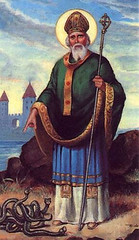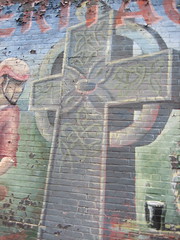St. Patrick
From The Peopling of New York City: Irish Communities
|
St. Patrick, Patron Saint of Ireland
Saint Patrick is an important figure in Irish history and culture, his life is surrounded by myth but there is much that we do know about him. He was supposedly born in Great Britain and was taken hostage as a teenager by Irish raiders attacking his family’s home and brought to Ireland and imprisoned. After living for years as a prisoner, it is said that he became a shepherd and roamed the Irish countryside. It was during this time, according to his legend, that he reconnected with God. During this time he also began to dream about converting the Irish people to Christianity. Saint Patrick then heard the voice of God to leave Ireland, and returned home to Great Britain.
He spent his time in England perfecting his missionary skills and growing more devoted to educating others about God. Saint Patrick reported hearing another voice, this time that of an angel telling him to convert the Irish to Christianity and he returned to Ireland.
Later, one of the most important and well-known events in Irish Culture is the celebration of St. Patrick's Day Parade, a representation of Irish pride. Saint Patrick’s day honors Saint Patrick, the patron saint and icon of Ireland, credited with converting Ireland to Christianity.
What many people are not aware of is that Saint Patrick is also thought to be the creator of the Celtic cross, which united Christ’s cross and Celtic symbol of the sun to combining Celtic traditions with that of Christianity to ease the process of conversion and allow the people to retain their culture.
St. Patty's Day at a Glance
Saint Patrick’s day honors Saint Patrick, the patron saint and icon of Ireland, credited with converting Ireland to Christianity. Saint Patrick was supposedly born in Great Britain and was taken as a teenager, hostage, by Irish raiders attacking his family’s home and brought to Ireland to live in imprisonment. After living for years as a prisoner of his captors, it is said that he became a shepherd and roamed the Irish countryside. It was during this time, according to his legend, that he ‘returned’ to his faith and reconnected with God. His time as a shepherd and in captivity is when he began to dream about converting the Irish people to Christianity. Saint Patrick then heard the voice of God to leave Ireland, and returned home to Great Britain. He spent his time there perfecting his missionary skills and growing more entrenched in his need to educate others about the word of God. After this time spent in England, Saint Patrick reported hearing another voice, this time that of an angel telling him that it was his purpose to convert the Irish to Christianity and he returned to Ireland.
Celebrating St. Patrick's Day
St. Patrick's Day Parade 2009 on March 17th on 68th street and 5th Ave Irish Bagpipe Players traditional music in honor of St. Patrick.
Roue of St. Patrick's Day Parade from 44th Street and 5th Ave to 86th Street and 5th Ave
The First St. Patrick's Day
The holiday of Saint Patrick’s Day traditionally takes place on March 17th, the date of his death and has been celebrated by the Irish for over a thousand years. The first parade held in his honor occurred on March 17th, 1762 and took place in New York City. Irish soldiers serving in the English army congregated in Manhattan and danced and played their music to help them reconnect with their culture. This expression of Irish pride would continue to grow in America and in the 19th century organizations began to sprout up and they each had their own smaller parades.
Then these organizations decided to pool their resources and celebrations and the modern day Saint Patrick’s Day Parade was born. [1]

